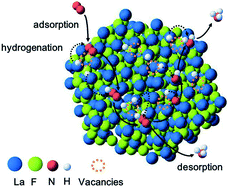Efficient nitrogen reduction to ammonia by fluorine vacancies with a multi-step promoting effect†
Abstract
Improving the performance of catalysts by adjusting the vacancy engineering is currently one of the main ways to design effective catalysts. However, there are no reports in the literature on the influence that fluorine vacancies (FVs) have on the electronic structures of materials. In this work, we report the generation of FVs for the first time and discuss in depth their regulation mechanism on materials and their role in the electrochemical N2 reduction reaction (NRR). The catalyst optimized by FVs showed good NRR performance in Li2SO4 solution. At 0 V vs. RHE, the faradaic efficiency (FE) reaches the highest value of 36.01%. When the potential is increased to −0.10 V vs. RHE, the highest ammonia yield is 7.99 μg h−1 cm−2. The specific activity of the FV-optimized LaF3 nanosheets (NSs) is 9.5 times higher than that of the defect-free LaF3 NSs. It is currently reported as the most effective non-noble metal catalyst in the nitrogen reduction process under low overpotential. In addition, this catalyst also demonstrates long-term structural stability. In situ attenuated total reflectance surface-enhanced infrared absorption spectroscopy (ATR-SEIRAS) and density functional theory (DFT) show that the LaF3 NSs with the optimal defects have a multi-step promoting effect.



 Please wait while we load your content...
Please wait while we load your content...